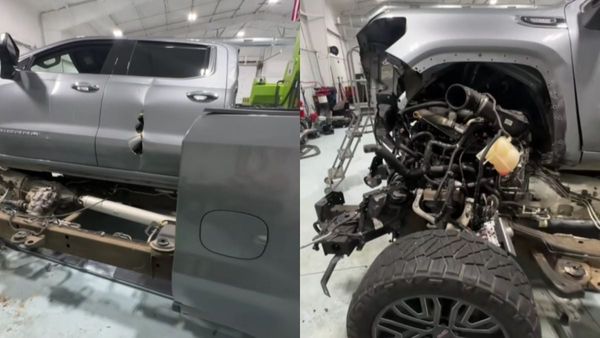Born in Luton in 1956, Paul Young is the heart-throb responsible for some of the biggest chart hits of the 1980s. After the breakup of new wave soul group the Q-Tips, Young went solo, providing the opening vocals on Band Aid’s Do They Know It’s Christmas? and releasing the transatlantic smash Every Time You Go Away and the multimillion-selling duet with Zucchero, Senza una donna (Without a Woman). Paul Young and Go West tour the UK in May; he takes The Essential 80s Tour with T’Pau and Hue And Cry on the road in the autumn.
This was one of those endless teen magazine photoshoots. I have a vague memory of the photographer asking me to stand like that; it was quite a tight-fitting jacket made of a stiff suede so it was difficult to lift my arms up high. The clothes were bought at Johnson’s on the King’s Road, where Adam Ant got all his mad suits from. I would have styled my own hair, too – I’m quite particular about it. Even today, I’ve got the right kind of product, so if it blows about it goes back to its original place.
The 80s were quite a peacocking era of masculinity, but I was tame by comparison, especially if you look at a group like Def Leppard. The hair products needed to keep them and some of those American guys on the go were quite something. I was probably a tempered version of the time, which reflects my personality. My fans probably preferred that I was a bit more understated.
I had a stammer growing up, pretty much from the get-go. My brother used to finish my sentences for me, which was very frustrating. I got time off school for speech therapy, but it didn’t do me much good. Then I found out that there were singers who lost their stammers when they performed, and that tapping a rhythm on your legs helps, too. I thought: I love music – if I do this for a living, I might be able to fix it and get some confidence.
I was doing an apprenticeship as a milling machinist at Vauxhall Motors with my dad when I fell in love with performing. He cajoled me into completing the apprenticeship, as any parent would, as he worried about money. He said, “I hope you’re saving some!” I was thinking: I can’t, when I make money I have to spend it on microphones and this and that and the other.
I was in a few groups before I went solo: Kat Kool and the Kool Kats, Streetband, followed by the Q-Tips. We were a bit of a motley crew and stayed together for three years. Those early days were a wonderful thing: the crowds would go nuts dancing, we’d play to this big sea of people, then you’d get up in the morning and wander around and be normal again.
After the band got dropped, I signed with CBS in 1982. My third single, Wherever I Lay My Hat, reached No 1 and I started selling out shows. The strategy involved in getting in and out of a gig became very technical. When I got my first security guy, I thought: Hey-hey! I’ve got a security guard. Would you believe it? By the time I realised it would be better to have one that stayed with me, and one that went on ahead, I stopped finding it so funny. Sometimes fans waited by the entrance of the venue to get autographs, so it would take an hour to get in. After the show, they would follow the tour bus back to the hotel. When I arrived I’d just be shoved in my room. I couldn’t go and have a drink with my friends in the hotel bar, so the fun started to go out of the experience a little bit.
I really didn’t like being a heart-throb. I was always wary of losing my sense of identity. I was conscious that in the end you become the persona that people want you to be. I always thought: if I can’t enjoy it, then is it worth doing? After about three years of being solo, it all became too lonely, so I said to my manager, “Can we stop for a while?”
I came back in the late 80s, but it was hard to ever really let loose. I always had to keep very sensible because I was doing it on my own. I used to be jealous of bands like Duran Duran because they could share the promo out. Instead I was doing the show, getting back at 1am, then up at 5am to do breakfast TV in New York. I was having no time off at all – I never even got to see America when I toured there. After the album in 1987, I felt as if I was making the wrong choices. I was trying to please the US label, and I was too influenced by other people’s opinions. I ended up taking some time out again. I just wanted to settle into my family life, with my wife and kids, and then start again from there. Get some grounding.
These days I’m much more comfortable doing solo tours. People often ask, “Don’t you get bored playing?” In the 90s, I was reluctant to keep going back to those early hits, but what helped was that I started a Tex-Mex band called Los Pacaminos – it gave me a chance to do all the things I can’t really do inside my solo career. I get a guitar in my hand and take a back seat. When I have an epitaph, I want to be seen to have had an eclectic career – that I tried a lot of different styles of music, and that I quietly went about my business. I never really repeated myself from album to album. I think that’s kept me going a little bit longer than some of the other stars from that period.
I like the way I look a lot better now than I did then. I know how to pose, what angles suit me better. Smiling helps as you get older. When you start to go grey, you try a few different things to stop the process. You dye your hair brown, but then the white hairs start growing back, and it looks unreal. I reached a point where I had to bite the bullet and now I don’t even mind growing a white beard. As for the jeans? I don’t think I’ll be wearing them any time soon. Faded denim doesn’t look good on a person of advancing age.







